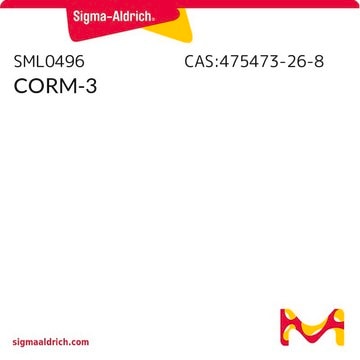SML0315
CORM-A1
≥95% (NMR)
Sinónimos:
Sodium boranocarbonate
Iniciar sesiónpara Ver la Fijación de precios por contrato y de la organización
About This Item
Fórmula empírica (notación de Hill):
CH3BNa2O2
Número de CAS:
Peso molecular:
103.82
Número MDL:
Código UNSPSC:
12352200
ID de la sustancia en PubChem:
NACRES:
NA.77
Productos recomendados
Nivel de calidad
Ensayo
≥95% (NMR)
Formulario
powder
condiciones de almacenamiento
desiccated
color
white to beige
solubilidad
H2O: >15 mg/mL
temp. de almacenamiento
room temp
cadena SMILES
[Na+].[Na+].[BH3-]C([O-])=O
InChI
1S/CH4BO2.2Na/c2-1(3)4;;/h2H3,(H,3,4);;/q-1;2*+1/p-1
Clave InChI
SOFPSQNQOQPAAJ-UHFFFAOYSA-M
Aplicación
CORM-A1 has been used:
- to deliver carbon monoxide (CO) and to test its cytoprotection in yeast and primary astrocytes culture during oxidative stress
- as CO donor in murine macrophages J774A.1 cells to test its effect on cellular β-endorphins elevation
- to test its effect on mitophagy activation in retinal ganglion cells
Acciones bioquímicas o fisiológicas
CORM-A1 is a water-soluble carbon monoxide (CO) releasing molecule that can be used to study the effects of CO on cellular systems. Carbon monoxide (CO), produced during the degradation of heme by the enzyme heme oxygenase is an important gaseous signaling mediator in mammalian cells CORM-A1 has anti-oxidant and anti-inflammatory activity.
CORM-A1 is a water-soluble carbon monoxide (CO) releasing molecule.
It mediates the release of CO in a pH and temperature-dependent manner, thus favoring mild vasorelaxation and hypotension. During oxidative stress, CORM-A1 is reported to provide cytoprotection in astrocyte primary cultures. This boron-containing CORM promotes autophagy.
Código de clase de almacenamiento
11 - Combustible Solids
Clase de riesgo para el agua (WGK)
WGK 3
Punto de inflamabilidad (°F)
Not applicable
Punto de inflamabilidad (°C)
Not applicable
Elija entre una de las versiones más recientes:
Certificados de análisis (COA)
Lot/Batch Number
¿No ve la versión correcta?
Si necesita una versión concreta, puede buscar un certificado específico por el número de lote.
¿Ya tiene este producto?
Encuentre la documentación para los productos que ha comprado recientemente en la Biblioteca de documentos.
Los clientes también vieron
Sara R Oliveira et al.
The European journal of neuroscience, 52(1), 2771-2780 (2020-03-14)
Previous studies about the modulation of the vasculature by CO were performed exclusively in male or sexually immature animals. Understanding the sex differences regarding systemic drug processing and pharmacodynamics is an important feature for safety assessment of drug dosing and
Helena Parfenova et al.
American journal of physiology. Heart and circulatory physiology, 315(4), H978-H988 (2018-07-22)
Neonatal asphyxia leads to cerebrovascular disease and neurological complications via a mechanism that may involve oxidative stress. Carbon monoxide (CO) is an antioxidant messenger produced via a heme oxygenase (HO)-catalyzed reaction. Cortical astrocytes are the major cells in the brain
Kapil K Upadhyay et al.
Redox biology, 28, 101314-101314 (2019-09-13)
Nuclear factor-erythroid 2 related factor 2 (Nrf2)-mediated signaling plays a central role in maintaining cellular redox homeostasis of hepatic cells. Carbon monoxide releasing molecule-A1 (CORM-A1) has been reported to stimulate up-regulation and nuclear translocation of Nrf2 in hepatocytes. However, the
Cláudia Figueiredo-Pereira et al.
FEMS yeast research, 19(5) (2019-07-26)
Autophagy is an autodigestive process, promoting cytoprotection by the elimination of dysfunctional organelles, misfolded proteins and toxic aggregates. Carbon monoxide (CO) is an endogenous gasotransmitter that under low concentrations prevents cell death and inflammation. For the first time, the role
Myrna Constantin et al.
International journal of hypertension, 2012, 859235-859235 (2012-04-21)
Heme oxygenase (HO), a catabolic enzyme, provides the rate-limiting step in the oxidative breakdown of heme, to generate carbon monoxide (CO), iron, and biliverdin-IXα. Induction of the inducible form, HO-1, in tissues is generally regarded as a protective mechanism. Over
Nuestro equipo de científicos tiene experiencia en todas las áreas de investigación: Ciencias de la vida, Ciencia de los materiales, Síntesis química, Cromatografía, Analítica y muchas otras.
Póngase en contacto con el Servicio técnico















